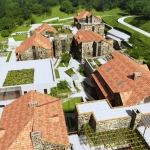Gyumri, the second large city of Armenia, has ancient history. It has been mentioned in the traveling notes of Greek historian Xenophon. The first historical information about settlement named Kumayri is provided by historian Ghevond (VIII century). During centuries the historical name of Kumayri is changed into Gyumri. The city is also changed. The economic development of the city begins especially after Russian-Persian and Russian-Turkish wars, when thousands of Armenians have migrated here from Erzurum, Bayazed, Mush and Kars. Making use of the advantages granted by Russian empire people decide to settle down with their families in the locality situated on the left bank of Akhuryan River beginning to build new houses to enrich the city.
On the occasion of finishing the construction of Sev Berd (Black Fortress) in 1837 Russian emperor Nicholas I arrived in Gyumri on October 4. By his order the city is renamed to Alexandrapol. The latter is declared as an urban residence in 1840 submitting to new and systematic mapping and building. It is known that Alexandrapol has been famous as a city of handicrafts, where the number of developing trades has always been beyond hundred. The handicrafts were used consonantly especially during constructional works of the city. Both architects and constructors, white smiths and carpenters left their lasting impression on each building constructed by the masters of Gyumri. And even today everyone can admire the splendor of laminated cornices of the buildings, ironclad gateways and the beauty of the wooden frames of the windows. It is noteworthy that not only museums and public edifices are built by all the principles of beauty but also all the houses where people live.
It is a real pleasure to walk along the streets of Gyumri. You can admire the nice view of the old buildings made of black polished stones with windows framed by red tufa. These buildings are preserved in complete districts. One can even sink in the indescribable beauty of the city. In this city there is an initial love which sometimes changes into an arched entrance or into an incrusted pitcher, and sometimes becomes pictorial canvas and musical works. Even the earthquake of 1988 was powerless to ruin the solid buildings made by the masters of Gyumri. Fortunately, they remain as the instruments of ratification of city’s antiquity and the certificates of the honesty of its population.
Gyumri, My Love
Back To Top










